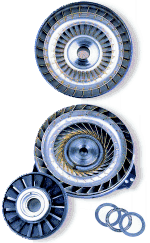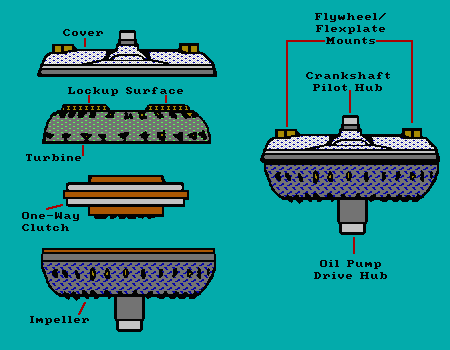|
|
|

Why is this necessary, or even desirable? In many ways, it comes down to fuel economy. Lockup torque converters have become popular since automakers have been stuck in a sort of Catch-22: Car buyers overwhelmingly prefer automatic transmissions, but automatic transmissions are not as fuel efficient as manual transmissions and automakers must meet government-mandated corporate average fuel economy targets. Overdrive transmissions have been one step along the path toward increased fuel economy from an automatic transmission. Overdrive transmissions allow the motor to spin at a lower rpm during cruising speeds. A higher final drive ratio (numerically lower) does the same thing.
However, when the engine spins more slowly, it creates more slippage within the torque converter, and more slippage creates more heat. Heat within the torque converter reduces fuel economy and can harm both the torque converter and the transmission. The solution is to allow the converter to lock up at a 1:1 ratio. Lockup eliminates the slippage, which reduces heat and improves fuel economy.
Do you want to know if your car has a lockup torque converter or if
it's working properly? Try this: Drive along at 50 mph or a slightly higher,
steady cruising speed. Depress the brake pedal ever so gently (not enough
to actually apply the brakes, but enough to turn on the brake lights).
See if you experience what feels like a slight downshift. Then release
the pedal very slowly and see if you feel a slight upshift. If you do,
the lockup mechanism is working properly. Usually, lockup converters are
used in stock applications, but not in higher-performance vehicles. However,
some drag racers choose to run lockup torque converters, too. It is possible
to lock up the converter at wide-open throttle manually (by using a switch)
or automatically (via a racing computer chip). It has been estimated that
locking up the converter at WOT in a relatively stock doorslammer, such
as a Buick Grand National, can pick up about a tenth in quarter-mile ETs;
however, it also speeds up wear and tear on the torque converter clutch.

Recently developed torque converters have had a "lockup" feature added to reduce this energy loss and improve mpg. This lockup feature will not engage until the vehicle reaches approximately 40 mph. Other factors may also prevent this type converter from locking up. Besides the speed sensing indicator, a converter may not lockup for any of the following reasons:
1. Engine temperature too cold - most converters will not lockup until the coolant reaches about 120°F.
2. Overdrive unit locked out - when an automatic overdrive is "locked-out" the torque converter lockup feature will also be locked out. Overdrive lockout would normally only be used when pulling heavy loads, thus the converter is logically "locked out."
3. Under low engine vacuum, heavy part-throttle acceleration is an additional power demand which could result in the engine lugging. To prevent engine lugging, which could result in serious engine damage, a sensor determines if low manifold vacuum exists.
Typical lockup converters connect these sensors in a series creating a "string" arrangement. That is, if one sensor gives a "no" signal then the converter will not lockup. Therefore, for most converters to lockup, the following must be present:
a. Coolant must be at or above minimum temperature.
b. Transmission selector must be in drive if a non-overdrive vehicle
or in "O" or "OD" overdrive if an overdrive vehicle.
c. Vehicle must be at or above minimum lockup speed.
d. Vehicle must be in a cruise or near cruise condition.
e. Transmission must have shifted into the top gear.
Some manufacturers add additional parameters to converter lockup. If any one sensor fails to complete the string, the converter will not lockup.
Malfunctions.
A converter may fail internally. Internal failure will reduce mpg and
affect vehicle performance. If the one-way torque converter clutch slips,
then the vehicle will characteristically have very poor acceleration. Mpg
will be significantly reduced since engine torque is not being multiplied
during acceleration. A vehicle with a slipping one-way torque converter
clutch will experience a 20 to 30% decreased fuel economy.
A one-way torque converter clutch that does not release is a second type of torque converter failure. Vehicles with a non releasing one way clutch will accelerate normally but at a decreased top speed. The failure results in a 30 to 50% reduction in mpg. Top cruising speeds are lowered to 40 or 50 mph. The transmission may shift normally even when the one-way torque converter clutch slips or fails to release properly!
Lockup torque converters may exhibit additional fuel-eating malfunctions. Sensors - temperature, speed, selector position, engine vacuum - may fail; wiring and connectors could fail or become disconnected. Internally, the lockup device itself could fail or wear out. Whatever the malfunction, mpg will be decreased.